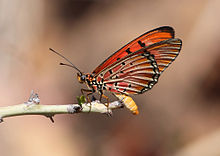Acraea aglaonice
| Clear-spotted acraea | |
|---|---|

| |

| |
| Dorsal and lateral aspect of male | |
| Scientific classification | |
| Domain: | Eukaryota |
| Kingdom: | Animalia |
| Phylum: | Arthropoda |
| Class: | Insecta |
| Order: | Lepidoptera |
| Family: | Nymphalidae |
| Genus: | Acraea |
| Species: | A. aglaonice
|
| Binomial name | |
| Acraea aglaonice | |
| Synonyms | |
| |
Acraea aglaonice, the clear-spotted acraea, is a butterfly of the family Nymphalidae. It is found in KwaZulu-Natal, Mozambique, Transvaal, Zimbabwe and Botswana.
Description[edit]

The wingspan is 43–49 mm for males and 45–55 mm for females. A. aglaonice Westw. Both wings above red-yellow nearly to the base with the usual black dots; the discal dots of the hindwing, however, are smaller than usual and discal dots 3 to 6 on the forewing are normally placed far beyond the apex of the cell, opposite to the origin of vein 10; the fore wing above without definite dark apical spot, only with narrow black marginal line as at the costal and distal margins; veins at the distal margin black; hindwing above with black, unspotted marginal band 2 to 3 mm. in breadth; wings beneath lighter, hindwing at the base with red spots and in the marginal band with streak-like whitish marginal spots. It is peculiar to this species that the forewing has nearly always in cellules 4 and 5 (and 6) small hyaline spots, just distally to the discal dots; in the female these spots are often whitish instead of hyaline. Natal; Transvaal; Mashonaland; Manicaland; Delagoa Bay. -ab. albofasciata ab. nov. Fore wing in the basal third blackish, in the middle black-grey and more or less transparent whitish, before the distal margin for a breadth of about 5 mm. grey-yellow with black veins; at the apex black for about 3 mm.; black marginal band only 1 mm. in breadth. Hindwing above black with a white median band 7 mm. in breadth, which encloses the comparatively large discal dots. Under surface light grey-yellow with yellow streaks on the interneural folds; forewing only with very fine black marginal line; hindwing with marginal band 2 mm. in breadth, enclosing large semicircular whitish marginal spots. Manicaland. Should probably be regarded as an extreme rainy-season form. [4]
Biology[edit]
Adults are on wing year round, with peaks in early summer and autumn. There are multiple generations per year.[5] The larvae feed on Passiflora edulis and Passiflora incarnata.
Taxonomy[edit]
Acraea caecilia species group See also Pierre & Bernaud, 2014 [6]
References[edit]
- ^ Woodhall, S.E.; Westrip, J.R.S. (2020). "Acraea aglaonice". IUCN Red List of Threatened Species. 2020: e.T161322759A161322797. doi:10.2305/IUCN.UK.2020-3.RLTS.T161322759A161322797.en. Retrieved 18 November 2021.
- ^ Westwood,J.O, 1881 Entomology in, Matabele Land and the Victoria Falls in Oates, Matabeland : 331-365, pl. E-H
- ^ "Acraea Fabricius, 1807" at Markku Savela's Lepidoptera and Some Other Life Forms
- ^ Aurivillius, [P.O.]C. 1908-1924. In: Seitz, A. Die Grosschmetterlinge der Erde Band 13: Abt. 2, Die exotischen Grosschmetterlinge, Die afrikanischen Tagfalter, 1925, 613 Seiten, 80 Tafeln (The Macrolepidoptera of the World 13).Alfred Kernen Verlag, Stuttgart.
 This article incorporates text from this source, which is in the public domain.
This article incorporates text from this source, which is in the public domain.
- ^ Woodhall, Steve (2005). Field Guide to Butterflies of South Africa. Cape Town, South Africa: Struik. ISBN 978-1-86872-724-7.
- ^ Pierre & Bernau, 2014 Classification et Liste Synonymique des Taxons du Genre Acraea pdf
External links[edit]
- Die Gross-Schmetterlinge der Erde 13: Die Afrikanischen Tagfalter. Plate XIII 55 d
- Acraea aglaonice Le Site des Acraea de Dominique Bernaud
- Acraea aglaonice Image collection Dominique Bernaud
- Images representing Acraea aglaonice at Bold

